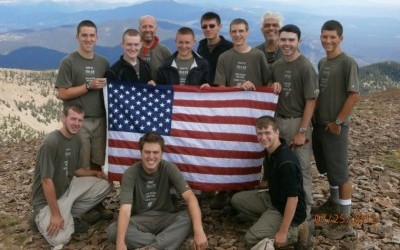For his summer vacation, Village of Mineola Mayor Scott Strauss took a hike with some Boys Scouts – a stroll spanning approximately 130 miles in the New Mexico desert that included climbing a mountain more than 12,000 feet high.
“It’s one of the most physically challenging things I’ve done in my life,” said Strauss, a fomer member of the New York City Police Department and the Mineola Fire Department.
It’s the second time in three years that Strauss, an assistant scoutmaster of Troop 45 in Mineola, has made the 11-day trek that’s meant to challenge the scouts’ survival skills and their ability to work as a team.
The locale was the Philmont Scout Ranch, a Boy Scouts of America national high-adventure base in Cimarron, New Mexico covering 214 square miles of vast wilderness.
Strauss and fellow assistant scoutmaster Lou Llanes were adult advisors for a crew of 10 Boys Scouts led by Eagle Scout Dylan Perro.
Strauss’s son Christopher was among the 10 boys, all Star, Life or Eagle scouts who elected to attempt an 83-mile trail in Philmont. Strauss had made a similar trek with his eldest son, Brian, in 2009.
After the group flew from LaGuardia airport to Denver on July 15, they spent the next two days touring parts of Colorado, including the U.S. Air Force Academy in Colorado Springs, Pike’s Peak and the Garden of the Gods outside Colorado Springs.
Troop 45 scouts, sponsored by the First Presbyterian Church in Mineola, make the Philmont trip every three years and traditionally choose one of the most challenging routes. The 80-mile trail becomes considerably longer with side excursions to find water and participate in other scouting activities along the route.
“The trek we picked was one of the super strenuous treks of 83 miles. But you have to find water and filter it,” Strauss said.
The scouts were traveling on minimal rations, dehydrated meals prepared with water that had to be boiled and nutrition bars they picked up along the way every few days at supply stations situated at intervals on the trail.
“The food they give you is not the best. We were starving. But you have to live on what you got,” Strauss said.
To prepare for the survival hike, the 10 scouts and their adult advisors had been training in extended hikes, including overnight camping, once a month for the past 18 months. They were also trained for wilderness first aid and certified in cardiopulmonary resuscitation so they could deal with medical emergencies with the nearest treatment centers miles away. And they had to be prepared for the rigors of hiking 15 to 20 miles daily during the 11-day trek.
“There’s not much room for error out there. These kids did a tremendous job,” Strauss said.
Apart from the physical rigor, there were natural dangers to deal with in a country inhabited by rattlesnakes, mountain lions and bears.
As the Mineola scouts were setting up camp late one afternoon, one of them spotted a black bear on a ridge high above them. It seemed harmless enough at first, and they reacted by breaking out their cameras.
“We thought it was pretty cool. We were taking pictures,” Strauss recalled
But the bear, a young adolescent, was curious and repeatedly approached the scouts’ campsite looking for an easy meal. The scourts banged pots to discourage the attention of the bear, who drew as near as 20 feet away from the campers before it finally gave up and went away.
The stress of being in wild country with no comforts of home, and no contact with family for nearly two weeks can naturally strain relations between the scouts. But monthly meetings Strauss held at his house, in addition to their monthly excursions, enabled the scouts to bond with each other.
“You’re dirty. You’re not taking showers. You smell. The atmosphere is ripe for arguments,” he said. “These guys worked real well together as a team.”
There were additional physical challenges along the trail to enhance team skills, including scaling a 15-foot high wall, rock climbing and rappelling on a mountain that was almost 9,000 feet above sea level and hiking up Philmont’s iconic rock, the Tooth of Time, a rock that stands at 9,003 feet above sea level.
They also climbed 40-foot-high spar poles, with harnesses attached to their waists, spurs attached to their legs and incredible scenery as a backdrop.
“The scenary is incredible,” Strauss said.
They also visited Waite Phillips’s hunting lodge. Phillips, founder of Phillips 66, donated the Philmont land to the Boys Scouts of America in 1938.
The penultimate challenge of the trip was climbing to the top of Mount Baldy, the highest peak in the Philmont at 12,441 feet. At that stage of the trek, the hikers had to rest for up to 30 minutes every 10 feet in the thin mountain air to reach the summit.
“But what a nice accomplishment when you get to that peak,” Strauss said.
Strauss said the experience was an exhilarating exercise that instilled self-confidence and mutual support in the Troop 45 hikers.
“It’s a high adventure trip. It’s a challenge. It’s a huge accomplishment to say ‘I went to Philmont’,” Strauss said.



